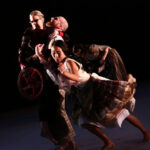Belly dance, a term that conjures images of rhythmic movements and exotic allure, boasts a rich and intricate history that spans centuries and continents. Understanding the history of belly dance requires navigating a complex tapestry of cultural influences, evolving terminology, and shifting perceptions across different societies. From its debated ancient roots to its modern global popularity, the journey of belly dance is as captivating as the dance itself.
Decoding the Terminology: Belly Dance and its Aliases
The name “belly dance” itself is a relatively recent invention, originating from the French phrase “danse du ventre,” literally translating to “dance of the stomach.” This term gained prominence in the West, particularly after the 1893 Chicago World’s Fair, where dancers were showcased, and the English term “belly dance” was popularized by showman Sol Bloom.
However, “belly dance” is not the only, nor necessarily the most accurate, descriptor. “Oriental dance” is another common term, though it carries geographical ambiguity and can mistakenly evoke images of East Asian dance forms. In Arabic, the dance is often referred to as “Raks Sharqi,” meaning “Dance of the East,” which more precisely locates its origins in the Middle East.
The term “danse du ventre,” and consequently “belly dance,” has been criticized for its potentially racist origins and misinterpretations, stemming from a Western, often colonial, gaze upon Middle Eastern cultures. Some argue for abandoning “belly dance” in favor of “oriental dance” or “raqs sharqi” to distance the art form from these negative connotations. Yet, “belly dance” remains the most widely recognized term in English-speaking contexts, and many argue that its modern usage has shed its racist baggage, becoming a neutral, albeit imperfect, descriptor.
The debate over terminology highlights the challenges in defining and categorizing this dance form. Academic Andrea Deagon proposed the term SITA (solo-improvised dance based on torso articulation), emphasizing key characteristics of some styles. However, SITA is not universally applicable, as it excludes group improvisational styles like tribal belly dance or choreographed raqs sharqi performances. Furthermore, SITA could encompass other dance forms not typically considered “belly dance,” such as Moroccan Shikhat.
Perhaps the most accurate approach is to recognize “belly dance” not as a singular, monolithic genre but as an umbrella term encompassing a diverse range of related dance styles with shared roots but distinct characteristics. This includes Raqs Sharqi, American Tribal Style Belly Dance, Raqs Baladi, and Shaabi, each representing unique expressions within the broader spectrum of what is commonly known as belly dance.
Unearthing the Origins: Ancient Roots and Cultural Influences
Claims of belly dance’s origins stretching back 6,000 years to ancient pagan fertility rituals are widespread but lack concrete historical evidence. While the fluid, circular movements of belly dance are indeed conducive to preparing the body for childbirth, linking it directly to ancient fertility cults remains speculative. Nevertheless, the association with femininity and empowerment has resonated, particularly with feminist movements in the West.
The most traceable lineage of what we recognize as belly dance today points to Egypt and Turkey. Examining the movement vocabulary reveals potential influences from India. Head slides, for example, are present in both Indian classical dances and belly dance, suggesting possible cultural exchange through migrations from India towards the Middle East and North Africa over centuries.
African dance traditions also likely contributed to the development of belly dance. Hip and chest shimmies, undulations, and circular movements are prominent in both African and Afro-diasporic dances, indicating a shared movement lexicon. However, these movements have evolved and adapted within each tradition, resulting in distinct stylistic nuances. For example, shimmies in belly dance possess a different quality and aesthetic compared to African shimmies.
A comprehensive historical and choreological study is needed to definitively map these cross-cultural influences and establish a precise timeline. The ephemeral nature of dance makes this a challenging endeavor. However, employing methodologies similar to linguistic studies tracing the evolution of Indo-European languages could offer valuable insights into the historical migrations of dance movements and traditions.
Belly Dance as Social Dance and Public Entertainment
In its Middle Eastern heartland, belly dance has deep roots as a social dance form, intrinsically woven into the fabric of women’s gatherings and celebrations. Historically and presently, women dance together in informal social settings. Anecdotally, in some cultures, the way a woman dances can even be observed by families seeking potential brides for their sons.
In Egypt, dance has long been integral to wedding festivities, encompassing both social participation and professional performance. Baladi dance exemplifies this social aspect. Today, Shaabi music dominates Egyptian weddings and social gatherings, and the associated dance style, while similar to Baladi in its grounded hip articulations, differs in structure, mirroring the pop-song format of Shaabi music compared to the improvisational yet patterned nature of Baladi instrumental music.
Beyond its social function, belly dance has also served as a form of public entertainment for centuries. Traveling groups in Egypt and Turkey, believed to have originated from India and migrated through Persia and Afghanistan, earned their livelihood through street performances, showcasing their dance skills. These nomadic performers likely both preserved their own dance traditions and absorbed local movement vocabularies, contributing to the cross-pollination of dance styles.
Turkish Belly Dance: The Legacy of the Çengi
In Turkey, these traveling performers were known as çengi. Historical records indicate their presence in Istanbul as early as the 15th century, where they primarily entertained female audiences with dance and song. Çengi dance was characterized by intricate hip work, torso articulations, and shimmies. They also incorporated props such as finger cymbals and veils, elements still prevalent in modern belly dance. Even today, çengi dancers continue to perform for tourists in Turkey, and their style has significantly shaped Turkish belly dance.
Egyptian Belly Dance: From Ghawazi to Raqs Sharqi
Egypt also had its public performers, not exclusively women, but also men (European influence later shifted the focus to female dancers). The ghawazi were an ethnic group who performed publicly in streets and in front of coffee houses, especially during public processions and saint’s day celebrations. Their performances included singing, dancing, and the use of props like canes and swords. Initially tolerated and taxed by authorities, public dance faced a ban in Cairo in 1834 due to pressure from conservative elements. While some performers continued outside Cairo, the economic opportunities were diminished.
However, the ban was lifted between 1849 and 1856, leading to the return of performers to Cairo. The early 20th century, particularly the 1920s, witnessed the rise of nightclubs catering to European audiences, profoundly influencing Egyptian dance. This era marked the birth of modern Raqs Sharqi.
Badiia Masabni’s Cairo nightclub in the 1920s was particularly influential. Dance adapted to the stage, incorporating choreography, group performances, and Western dance influences like ballroom and ballet. Costumes also underwent a transformation. The traditional attire of a long skirt, shirt, and waistcoat evolved into the iconic “bedlah” – a bra, skirt, bare midriff, adorned with veils, glitter, and beads.
Belly Dance in Western Society: From Exoticism to Empowerment
Middle Eastern dance reached Europe and the USA primarily through European travelers to the Middle East and North Africa from the late 18th and 19th centuries. Traveler reactions were varied, ranging from fascination to condemnation. However, predominantly male travelers often had limited access, mainly observing street performers or dancers willing to perform privately for male audiences, contributing to a skewed and often negative perception of the dancers’ reputation.
Universal exhibitions played a crucial role in popularizing belly dance in the West. The 1893 Chicago World’s Fair, featuring the dancer Little Egypt, sparked both fascination and controversy. Her torso-centric movements, a stark contrast to the corseted fashions of the time, were considered scandalous by some but captivating by others. Imitators emerged, often exaggerating hip and torso movements, sometimes leading to interpretations deemed vulgar.
Western audiences often viewed the “Orient” through a lens of exoticism and moral ambiguity, shaping perceptions of oriental women and dance. This romanticized and often distorted image was further perpetuated by popular literature and Hollywood films. Belly dance also influenced burlesque in the 19th century, blurring the lines between the two genres in the public imagination.
The feminist movements of the 1970s and 1980s brought a significant shift in the Western perception of belly dance. Women, initially in the USA and subsequently globally, rediscovered belly dance as a powerful and empowering dance form. While men in the Middle East continue to dance folkloric styles, their presence in Raqs Sharqi is less common. In the West, male belly dancers exist but remain a minority.
Organizations like IAMED (International Academy of Middle Eastern Dance) continue to promote the understanding and appreciation of belly dance. The history of belly dance is a dynamic and evolving narrative, reflecting cultural exchange, societal shifts, and the enduring power of dance as a form of expression and empowerment.
References
- Shay, A. and B. Sellers-Young (2003). “Belly Dance: Orientalism: Exoticism: Self-Exoticism.” Dance Research Journal 35(1): 13-37.
- Nieuwkerk,K. (1995), A Trade like Any Other: Female Singers and Dancers in Egypt. University of Texas Press.
- Dinicu, C (2013), You Asked Aunt Rocky: Answers & Advice about Raqs Sharqi and Raqs Shaabi. Rdi Publications.
- Lo Iacono (2019) – Dance as Living Cultural Heritage: A Transcultural Ethnochoreological Analysis of Egyptian Raqs Sharqi.


